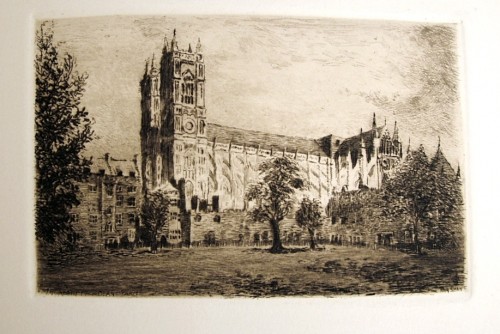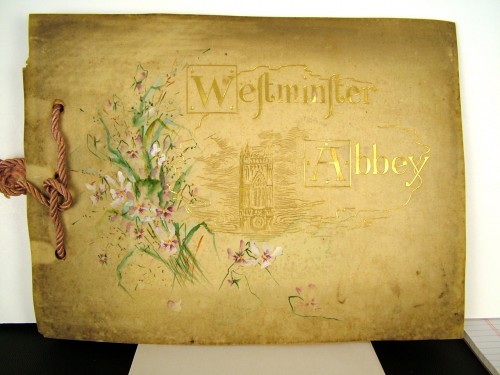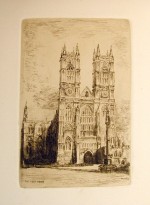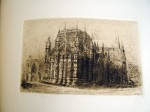Westminster Abbey – Complete Bound Set

John Sloan ((1871-1951), Westminster Abbey, c. 1891, the complete set of13 etchings, ribbon bound with ahand-painted gilt cover [many of the etchingssignedand variously annotated in the plate]. Reference: Morse 11-23, only state. Printed byPeters Brothersand published byA. Edward Newton (1864-1940).Theetching imagematrices are in excellent condition, thefull sheets with wide margins (slight soiling and foxing near margin edges, the first (blank) page with some losses; other pages with nicks, some water stains not near images). Etchings are c. 3 1/4 x 5,the sheets 8 x 10 1/4 inches.
These etchings are finelyand delicately printed in dark brown or sepia ink on heavy wove paper;an exceedingly rare set of these very early Sloan etchings.
Morse knew of only one complete set of Westminster Abbey, in the Philadelphia Museum of Art, which is also with an embossed and painted cardboard cover (also with the illustration of hand-painted flowers, but in the Philadelphia set the flowers are placed a bit further to the right) tied with a ribbon (a flat ribbon in Philadelphia, braided here).
Although the publisher’s name is not on the volume,Sloan recalled doing this series forA. Edward Newton, who in later years became America’s most revered rare book collector. Sloan had worked at a bookshop in Philadelphia called Porter and Coates after high school, where Newton was a young salesman. After Newton left and set up a “fancy goods” business he recruited (with a three dollar a week raise) Sloan as a designer, and Sloan, who had learned etching techniques from reading at Porter and Coates,suggested doing some etching sets. Hecreated the Westminster Abbey series after photogravures made after paintings by English artist Alfred Dawson (Sloan never left the US). Size differences and other comparisons with a few of the photogravures that have been located show that Sloan did not trace them but copied them freehand.
Although A. Edward Newton achieved fame as a rare book collector and author, very little is known about the few early “books” he did with Sloan, including the size of the editions. Morse noted that “In many respects[Newton] was the first man to popularize book collecting beyond a small select group. For this reason his works have themselves become the object of book collectors…” Yet although this bound set is quite beautiful, and may have been produced in relatively large numbers, this appears to be the onlybound complete set knownoutside of the Philadelphia Museum set.
The 6 illustrative plates are signed by Sloan and variously titled and annotated,e.g., the Poet’s Corner includes names of several poets. The 6 title plates have verses as well as titles and are illustrated with decorative designs, e.g.,the West Front title with an “Ancient Coronation Chair”; the Poet’s Corner title with a harp; the Henry VII Chapel title with a knight’s armor and shield.
It is likely that Sloan designed the gilt tower on the cover, which is very similar to the etched tower; the hand painted flowers may have been done by him or, more probably, by one of the 28 (!) women of varying ages who worked at Newton’s with Sloan (the only male) painting frolicking French lovers and flowers and on the covers of candy boxes, portfolios, and novelties at Newton’s store.






